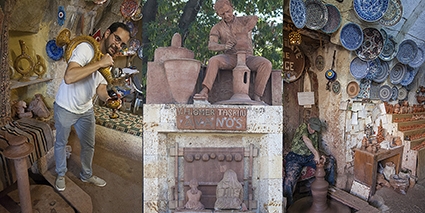To Nino’s House, Part 3
Let us continue our exploration of the region of Turkey in Cappadocia, where my wife and I recently spent a week of wonder.
The name first appears in the 6th century BC, and is also found as a place name in the New Testament, in the Acts of the Apostles. Although its origin is Persian, so neither Greek nor Turkish, the Turks have left it as the most common and well-known version.
Cappadocia has been tunneled into extensively by its various settlers from millennia ago right to yesterday, the rock being ideal for this and the needs for caves being extensive. The place is simply “Vardzias upon Vardzias”, as I described it to Georgian friends upon returning, to try to convey how wide-spread is the set of systems. There are so many whole underground cities, with new ones being found, new tunnels connecting some of them, that one could spend a lifetime underground and never discover it all. It reaches that far.
Monasteries, cave complexes taken over by new believers fleeing persecution from pagan Rome and then Islam, hermitages: there was no shortage of Christians settling here. They added entire underground churches or churches cut into rock, their interior surfaces elaborately and beautifully painted in fresco (“fresh”, paint on wet plaster) or dry styles; one of these we shall discover together soon. The temperature of the underground parts, which go many stories down, remains a constant 16 to 18 degrees C no matter the season on land, which makes them useful for food storage, though they are a bit cold and damp for comfortable long-term habitation, with mesothelioma, a type of cancer usually attributed to asbestos, affecting people who are genetically disposed to it if they live underground too long. Cappadocia’s summers can be long, dry and hot, winters plunging down to the minus twenties C, so the stable temperature makes a considerable difference.
The soil here is thin, half a meter to a meter, although it is rich in volcanically deposited minerals, and under it is rock. The soil’s quality allows good crops of potatoes, pumpkins, fruit trees, grapes and grains, well watered by irrigation, but larger trees would need deeper ground in which to root themselves.
Pottery is also very popular here, mostly thrown on foot-kicked wheels, richly and very finely detailed in glazes. I sat down at a kick-wheel for the first time in over thirty years, in the town of Avanos. This was my first experience of a non-electric wheel, and I found the necessary coordination of hands and feet tricky, the latter distracting me from concentrating enough on the former. My earthenware piece was nothing to want to dry and fire, but I thoroughly enjoyed myself (see photo, right) in the studio of a father who has been doing this for over thirty years and his son (see photo, left, pouring from a wine bottle of ancient design), who joined him six years ago. The son’s Instagram site is https://www.instagram.com/gizemli_magara/?hl=en for your interest.
Another fond memory I have is of throwing a lump of porcelain or stoneware from hand to hand, letting it roll a bit on my canvas-covered table with each pass so it would slowly dry out. This produced a cracked surface texture by natural means, impossible to predict in detail, only in the broad effects, thus full of surprises. Like the rocks of Cappadocia. More than once I felt that the piece was “telling me it was finished”, and I obeyed by stopping, then hollowing it from underneath to prevent cracking, letting it slowly dry out to “bone dry”, then giving it an initial bisque firing to remove all the chemically locked in water and finally the high-temperature finish in the kiln. These remain some of the pieces I am most pleased with, part chaotic, part planned. Thus, too, does an eroded landscape like Cappadocia inspire; if I lived here, my only profession of interest would be sculptor.
Tony Hanmer has lived in Georgia since 1999, in Svaneti since 2007, and been a weekly writer for GT since early 2011. He runs the “Svaneti Renaissance” Facebook group, now with nearly 1500 members, at www.facebook.com/groups/SvanetiRenaissance/
He and his wife also run their own guest house in Etseri:
www.facebook.com/hanmer.house.svaneti
Tony Hanmer












